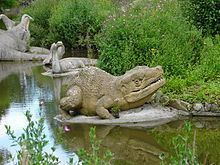Kingdom Animalia Clade Tetrapodomorpha Scientific name Stegocephalia | Phylum Chordata Clade Elpistostegalia Higher classification Tetrapodomorpha | |
 | ||
Clade Stegocephalia
Cope, 1868 Similar Fringe‑finned fish, Temnospondyli, Ichthyostega, Chordate, Cotylosauria | ||
Stegocephalia is a name used for four-limbed stem-tetrapods, and their amphibian-grade descendants, and in phylogenetic nomenclature for all tetrapods. The term was coined in 1868 by American palaentologist Edward Drinker Cope and comes from Greek στεγοκεφαλια - "roofed head", and refer to the copious amounts of dermal armour some of the larger primitive forms evidently had. Canadian paleontologist Michel Laurin gave the group its first formal phylogenetic definition, roughly including all vertebrates with toes rather than fins.
Contents
History of classification
Originally, the term was used as a systematic unit at the rank of order. The term rose to prominence in American and British science in the 19th century, though the largely equivalent term Labyrinthodontia had been coined 18 years earlier by Hermann Burmeister in reference to the tooth structure. The terms were used interchangeably during the early 20th century, usually divided into three orders. However, the Stegocephalia (and the Labyrinthodontia) being paraphyletic, the name is now used in an informal way to denote the early non-piscine vertebrates, excluding amniotes (the first reptiles and their descendants) and modern lissamphibians).
Paleontologist Michel Laurin took up the older term and defined stegocephalians cladistically as all vertebrates more closely related to temnospondyli than to Panderichthys (the closest relative of tetrapods known to have retained paired fins, see below) Therefore, Stegocephalia includes all vertebrate groups that have toes rather than fins, and a few (Elginerpeton, Metaxygnathus, Ventastega and possibly Hynerpeton) that may have retained paired fins. Contrary to the old usage of this term, the Stegocephali refers to a clade in this scheme. This concept of the clade Stegocephalia was chosen to substitute for the name Tetrapoda by those who sought to restrict Tetrapoda to the crown group. As such, it encompasses all presently living land vertebrates as well as their early amphibious ancestors.
Phylogeny
Below is an evolutionary tree of stegocephalians, as recovered from an analysis by Swartz in 2012.
